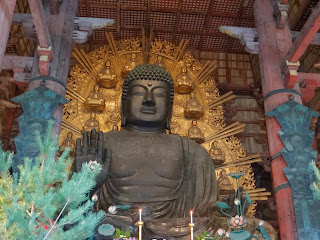The 2 major reasons for visiting Hiroshima are the Peace
Park and the island of Miyajima. The
city itself is quite nice, nestled in a valley surrounded by mountains with the
sea on the eastern side. It’s not a
large city by the standards of Tokyo and Kyoto, but wide boulevards with trams
and excellent public transport, make it easy to get around.
The city was the site of the dropping of the first atomic
bomb on August 6, 1945 and the Peace Park is dedicated to remembering that
occurrence and the wish that such an event should never happen again. The Park’s major feature is the preserved
remains of the only significant building left standing within a radius of 1 km
– the A-Dome as it’s called. Pictures of
the devastation around it are quite eerie and surreal and the historical record
indicates that the Americans seemed to use the dropping of the bomb, as a test
to determine what effect it would have, as they also dropped testing equipment
and the war was in its last days anyway.
However, that discussion is one for others and I for one don’t involve
myself in the politics. The Peace Park
also contains a museum of articles recovered and a photographic and historical
record of the event and it is an extremely moving and emotional feeling,
walking through the museum. The A-dome
was an exhibition hall for the local prefecture before the bombing and the
epicentre of the bomb’s blast was some 600 metres above it and about 100 metres
to the east. The dome on the building
was covered in copper and the copper melted instantly and fell into the
building, but the dome structure in steel remained standing, as did many of the
walls of the building, whilst almost everything around it to a radius of 2km,
was destroyed. The blast killed around
140,000 people! I’ll say no more!
Hiroshima is the city of origin of the cuisine known as
okonomiyaki, which is essentially a huge pancake containing fish or meat,
vegetables and egg, cooked on a hotplate, but the variations we’ve had up ‘til
now haven’t captured the dish’s true character.
Last night, however, we visited a restaurant which is renowned as THE
place to taste the original and best and it didn’t disappoint! The place is called Rei Chau and was
extremely crowded and noisy, but the okonomiyaki was superb! The original contains lots of finely sliced
cabbage, which many versions don’t seem to repeat. The taste is divine, particularly as we had
it with shrimp and squid. I think we may go and do it all over again tonight.
This morning we caught the train to Miyajimaguchi which is
the ferry terminal for the island of Miyajima, only a couple of k’s off the
mainland in the Sea of Japan. The island
was first established as a Buddhist retreat in 593 and the first torrii gate
for the shrine was built at that time, in the shallows of the sea at the
entrance to the shrine. The image of this
torii gate is known around the world and the place is hugely popular with tourists
from all over the world as well as large numbers of Japanese tour groups. The shrine and the torii gate are also
heritage protected.
The island’s other attraction is a climb to a cable-car
station and a ride to the top of Mount Misen but the view today was a little
hazy as it was overcast and a little dull, but non-the-less was well worth
doing.
Tomorrow – off to Osaka!













































